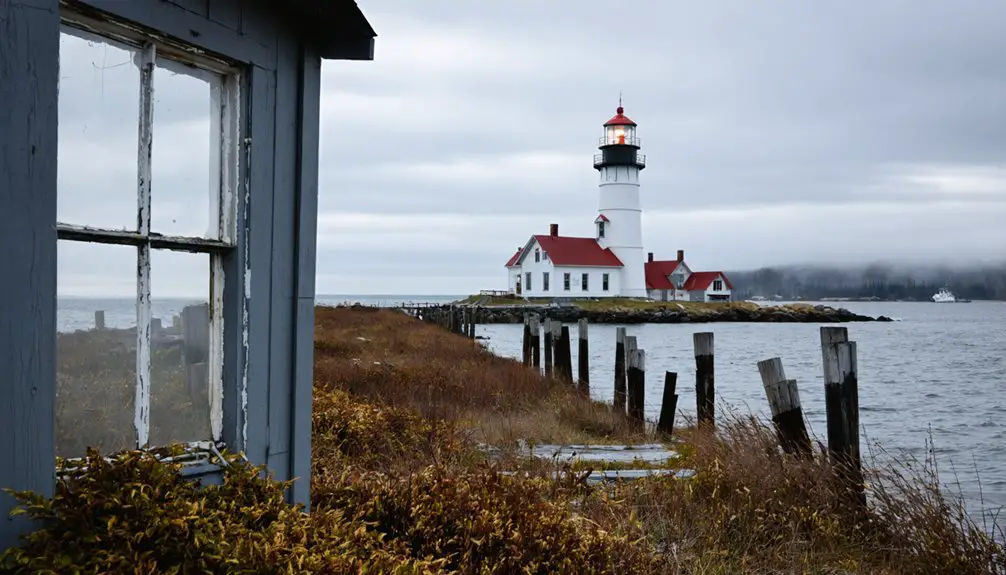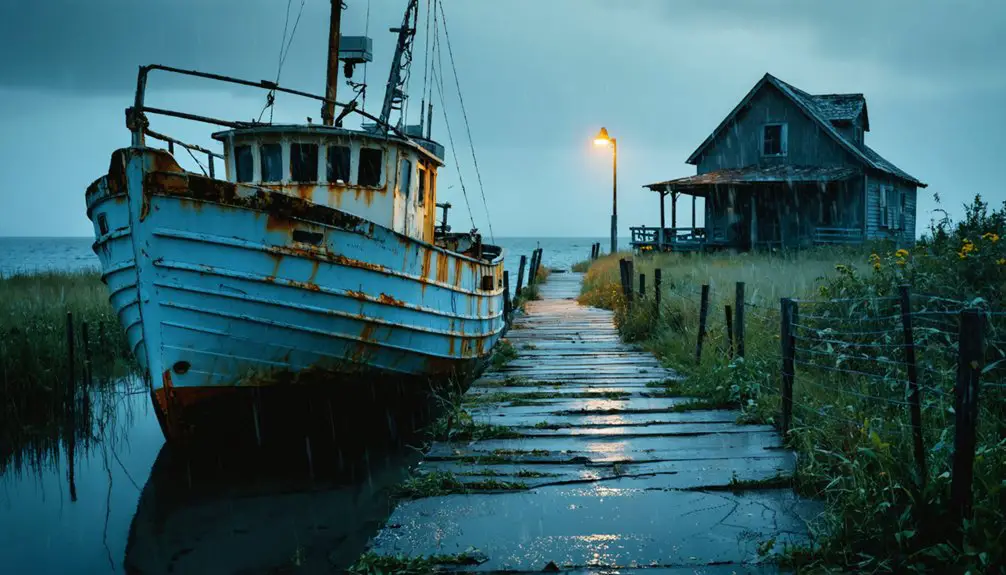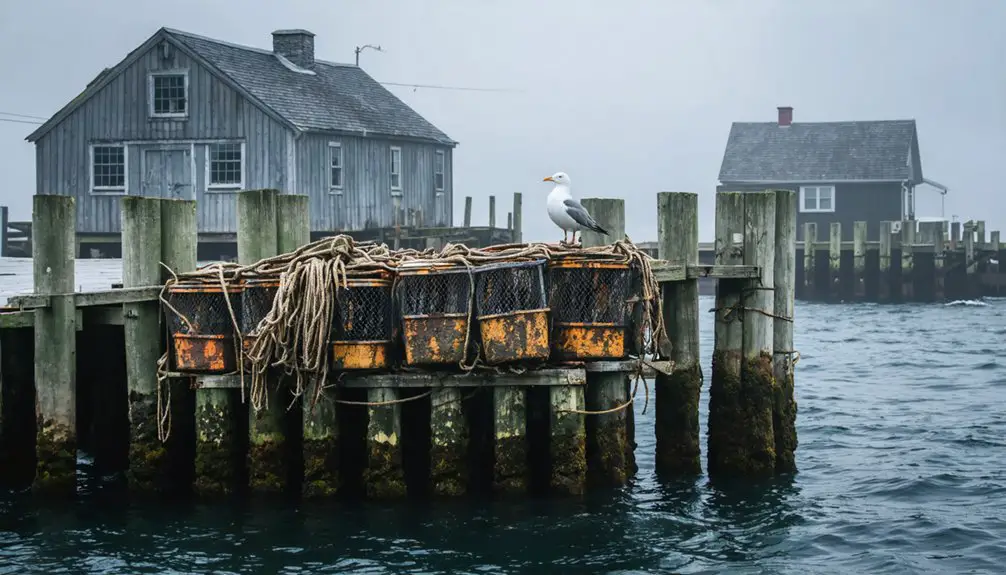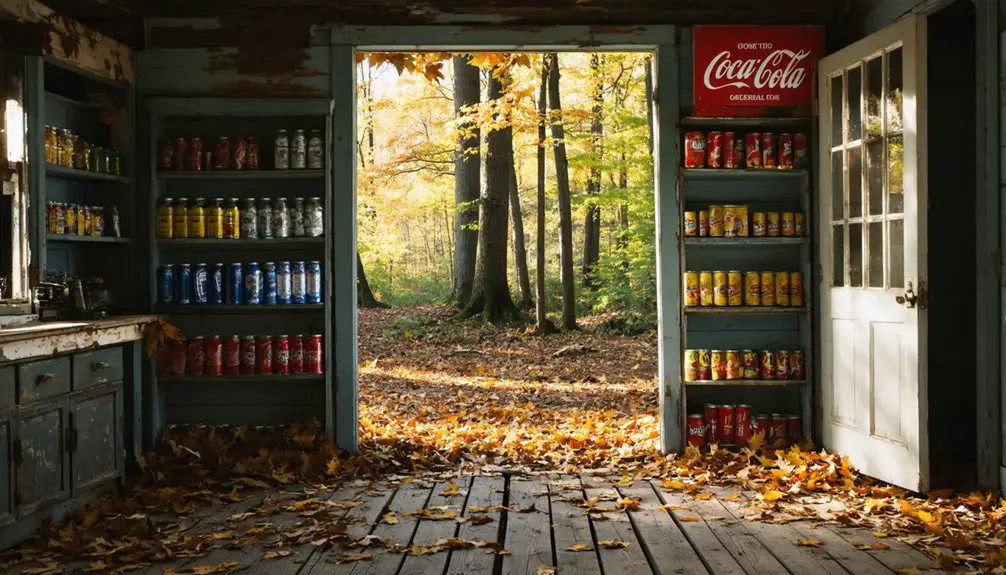You’ll find Frenchboro, Maine transforming from a thriving fishing community into a concerning demographic decline, with its population dropping from 61 residents in 2010 to just 30 by 2025. The island’s median age of 80.1 years and lack of young residents signal serious sustainability challenges. Despite this, the community’s maritime heritage remains strong through its fishing industry and nine generations of islanders. The story of Frenchboro’s fight for survival reveals a deeper tale of resilience and adaptation.
Key Takeaways
- Population decline from 61 residents in 2010 to approximately 30 in 2025 indicates significant demographic shrinkage.
- The median age of 80.1 years and 76.47% elderly population suggest an unsustainable demographic structure.
- No children under 14 live on the island, threatening long-term community viability and generational continuity.
- Geographic isolation and limited access to healthcare and services contribute to population loss and community challenges.
- Despite decline indicators, Frenchboro remains inhabited with functioning institutions and active fishing industry, unlike typical ghost towns.
The Lost Generation: A Population in Decline
While many Maine coastal communities have experienced population changes in recent decades, Frenchboro stands out for its dramatic demographic decline, with resident numbers plummeting from 61 in 2010 to approximately 30 in 2025.
You’ll find this remote island facing unprecedented challenges as youth migration has stripped away its demographic foundation, leaving behind an aging population with a median age of 80.1 years.
The stark reality of community sustainability becomes clear when you consider there are no children under 14 living on the island, and the elderly outnumber working-age residents by 150 to 100.
This aging trend is particularly evident as seniors aged 65-plus comprise 76.47% of the total population.
Unlike growing neighbors such as Deer Isle and Swan’s Island, Frenchboro’s population loss exceeds 50%, marking it as one of the most severe cases of decline among Maine’s island communities.
The island’s isolation stands in stark contrast to communities near Ellsworth’s growth, where eight contiguous towns added over 1,300 new residents.
Maritime Legacy and the Fishing Industry
You’ll notice dramatic changes in Frenchboro’s maritime infrastructure as fishing vessels evolved from traditional schooners to steam-powered trawlers in the early 1900s, fundamentally altering the harbor’s character.
The Lunt family heritage, spanning over two centuries of fishing these waters, has been integral to shaping the community’s maritime traditions. The harbor’s facilities had to adapt to accommodate larger vessels and new fishing technologies, while preserving spaces for the growing lobster fleet that would become the town’s economic backbone. The transition to modernized fishing methods like tub trawling represented a significant shift from traditional hand-line fishing practices.
Through generations of change, Frenchboro’s fishing families maintained their maritime legacy by passing down lobstering traditions and adapting their practices to modern regulations and equipment.
Evolving Boat Technologies
As fishing methods evolved in Frenchboro during the 19th century, local fishermen shifted from simple hook-and-line operations near shore to more sophisticated vessel technologies. The boat evolution revolutionized how you’d fish these waters, transforming from daily trips to extended voyages aboard schooners equipped with dories. These fishing advancements opened up access to rich grounds like the Grand Banks. The Lunt family business helped establish early maritime commerce through shipping wood, fish and paving stones. The transition created significant community conflicts between traditional sailing vessel crews and new steam-powered operations.
- Steam-powered trawlers replaced traditional schooners around 1900, dramatically increasing fishing range and efficiency.
- Longlines evolved from wooden tubs to mechanized systems, with lines stretching 1,800 feet.
- Crews adopted gill nets and various mesh-sized trawl nets for different species.
- Dories carried longlines with hooks every six feet, maximizing catch potential.
- Technology improvements enabled deeper offshore fishing and larger annual catches.
Harbor Infrastructure Changes
Since its establishment, Frenchboro Harbor has undergone significant infrastructure changes to support its essential fishing and transportation needs.
The harbor redesign in 1977 created a dual-anchorage system with a 10-foot-deep outer harbor spanning five acres and a six-foot-deep inner harbor covering 1.5 acres, connected by a 75-foot-wide channel.
Infrastructure upgrades have focused on maintaining the harbor’s working waterfront character. You’ll find commercial fishing facilities, including unloading docks and boat maintenance yards, concentrated in specific zones. The harbor serves as a crucial base for local fishing operations, reflecting its primary function in the region.
The ferry terminal at East Shore Road, gifted by Maine Coast Heritage Trust, provides vital mainland access to Mount Desert Island.
While the harbor lacks extensive marina amenities, this reflects the community’s commitment to preserving its traditional fishing heritage rather than catering to recreational boating.
Lobstering Through Generations
The rich tradition of lobster fishing in Frenchboro traces back to the 1850s, when commercial operations began using innovative lobster smacks equipped with seawater tanks to transport live catches to urban markets.
You’ll find nine generations of islanders who’ve mastered fishing techniques passed down through family lines, preserving lobster traditions that sustain this remote community. Conservation measures established in the late 1800s helped protect the lobster populations that families relied upon.
- Children start learning trap-setting skills at a young age
- Multiple generations often fish together, sharing boats and knowledge
- Families maintain their own unique fishing spots and techniques
- Early fishermen combined lobstering with farming and other seasonal work
- Community members collaborate to maintain shared maritime heritage
While lobstering was once considered a low-value pursuit, these family operations transformed it into a thriving industry that continues to define Frenchboro’s cultural identity and economic backbone. The shift from wooden vessels to fiberglass boats in the 1970s marked a significant evolution in the community’s fishing fleet.
Historical Name Changes and Early Settlement
Frenchboro’s evolution through various names reflects its complex administrative history, beginning in 1840 as Long Island Plantation, also known as Lunt’s Long Island Plantation.
The name origins shifted when it became Islandport in 1857, though this incorporation lasted only a year before reverting to its plantation status. In 1979, it finally incorporated as Frenchboro, named after E. Webster French, who established the island’s first post office.
Settlement patterns reveal multiple failed attempts in the early 1800s until permanent success in 1822.
Early settlers struggled repeatedly to establish themselves on Frenchboro, facing island hardships until finally succeeding in 1822.
While the Penobscot people previously used the island seasonally for fishing and gathering, continuous habitation began with this successful settlement. Today, fishing and lobstering remain the primary economic activities that have sustained the community for over 200 years.
Rich’s Head area once supported a separate year-round community but now lies abandoned, a reflection of the challenges of island living.
Lighthouse Tales and Research Station Evolution

Established in 1890, Great Duck Island Light Station emerged as an essential secondary seacoast light near Mount Desert Island, featuring a distinctive 42-foot cylindrical brick tower that guided mariners through Blue Hill Bay.
The lighthouse history reflects the evolving needs of maritime safety, shifting from manual operation to automation in 1986. Today, its research impact continues through the College of the Atlantic‘s marine research station.
- Original fifth-order Fresnel lens upgraded to fourth-order in 1902
- Steam-operated fog horn and 1,200-pound backup bell guaranteed safe passage
- Three six-room keeper’s dwellings and support buildings remain intact
- Current VRB-25 rotating beacon flashes red every 5 seconds
- College of the Atlantic conducts crucial ecological and marine studies on-site
Island Life and Cultural Preservation
While Great Duck Island’s lighthouse now serves researchers, life on neighboring Frenchboro tells a compelling story of cultural resilience and maritime tradition.
You’ll find a tight-knit community of just 61 residents, including ninth-generation islanders, who’ve maintained their cultural continuity through lobstering – a practice spanning two centuries.
Despite challenges that turned surrounding islands into seasonal destinations, Frenchboro’s community resilience shines through its growing population and preserved institutions.
The Maine Coast Heritage Trust‘s conservation efforts have protected the island’s natural landscapes while supporting traditional activities.
You can experience this enduring heritage at the annual Lobster Festival, visit the local museum, or explore the Long Island Preserve’s trails.
The Off Shore Store, school, and deli continue serving as essential community anchors, ensuring Frenchboro’s maritime culture thrives.
Surviving Against the Odds: Modern Challenges

Despite its enduring maritime spirit, modern Frenchboro faces significant challenges that test its resilience daily. You’ll find a community grappling with limited economic diversification opportunities while battling geographic isolation. The absence of basic healthcare access forces you to travel to the mainland for medical needs, highlighting the stark realities of island life.
- High living costs due to mainland dependency for groceries and essential services
- Infrequent ferry service limiting transportation and supply chain reliability
- Coastal erosion and sea-level rise threatening waterfront properties
- Aging population straining community sustainability
- Limited internet infrastructure hampering remote work possibilities
These challenges create a complex web of obstacles for residents, yet they persist in maintaining their unique way of life, adapting to modern pressures while preserving their cherished island heritage.
Frequently Asked Questions
What Is the Best Time of Year to Visit Frenchboro?
You’ll find peak experiences from June through August when summer activities are in full swing, though September brings stunning autumn colors with fewer tourists and comfortable temperatures.
How Do Visitors Reach Frenchboro From the Mainland?
You’ll need to take the Maine State Ferry from Bass Harbor Terminal to reach Frenchboro. The access route requires advance booking, and you’ll want to check seasonal schedules for the 50-minute crossing.
Are There Any Hotels or Lodging Options on Long Island?
You won’t find hotels or lodging directly on Long Island itself. For accommodations, you’ll need to stay on mainland Frenchboro, where vacation rentals and hotels start from $88 per night.
What Wildlife Species Can Commonly Be Spotted Around Frenchboro?
You’ll spot bald eagles nesting, seabirds soaring, and songbirds fluttering during bird watching adventures. Marine life includes seals, porpoises, and whales, while mink, hares, and deer roam the forests.
Does Frenchboro Have Regular Ferry Service or Scheduled Transportation?
You’ll find limited but regular ferry schedules, with service running Wednesdays, Thursdays, Fridays, and Sundays from Bass Harbor. Transportation options include passenger-only trips and vehicle transport requiring advance reservations.
References
- https://maineanencyclopedia.com/frenchboro/
- https://guides.cruisingclub.org/harbor/frenchboro-long-island/
- https://www.islandinstitute.org/island-journal/where-the-harbor-bears-your-name/
- https://frenchboro.lib.me.us/HistoricalSociety.html
- https://www.smithsonianmag.com/arts-culture/the-life-and-times-of-a-maine-island-39225074/
- https://www.neilsberg.com/insights/frenchboro-me-population-by-age/
- https://www.bangordailynews.com/2021/08/17/news/hancock/growth-in-ellsworth-area-drives-hancock-county-population-increase/
- https://worldpopulationreview.com/us-cities/maine/frenchboro
- https://www.islandinstitute.org/2021/08/20/more-people-have-moved-to-maines-remote-islands-in-the-last-decade/
- https://www.maine-demographics.com/frenchboro-demographics



